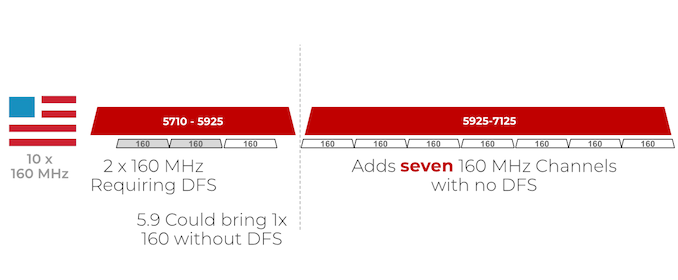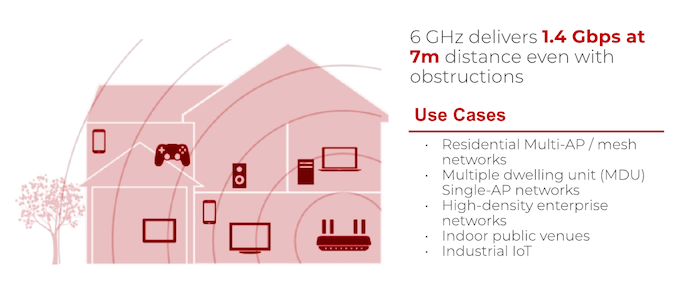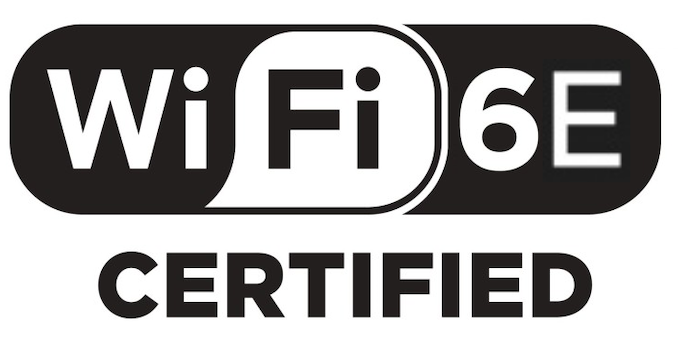Wi-Fi Alliance Announces Wi-Fi 6E Moniker for 802.11ax in the 6 GHz Spectrum
by Ganesh T S on January 6, 2020 3:35 PM EST- Posted in
- Networking
- Trade Shows
- Wi-Fi
- Wi-Fi Alliance
- CES 2020
- Wi-Fi 6E
- 6 GHz

Wi-Fi platform vendors have long been citing the lack of enough spectrum in the 2.4 GHz and 5 GHz bands as true gigabit wireless becomes commonplace. In fact, despite support for 160 MHz channels in the Wi-Fi 6 standard, very few consumers are able to actually utilize it because the dynamic frequence selection (DFS) feature is often disabled by default. DFS is necessary to prevent Wi-Fi devices operating in the 5 GHz band from interfering with radars that are licensed users of the channels in that band. Wi-Fi devices essentially use unlicensed spectrum for communication. As more and more gigabit wireless devices get deployed, the available spectrum capacity in the 5 GHz band may soon get exhausted.
Unlicensed Operation in the 6 GHz Band
The FCC has been considering the opening up of the 6 GHz band (essentially, the 1.2 GHz unlicensed spectrum span just above the currently used 5 GHz band) for unlicensed operation. Wideband unlicensed channels of 160 MHz and more may become essential to achieve expected performance from 802.11ax, 802.11be, 4G LTE, and 5G NR in unlicensed spectrum. Opening up a continuous 1200 MHz chunk will enable substantial amount of new bandwidth over multiple wide bandwidth channels.
Opening Up 6 GHz Enables Additional 160 MHz Channels (Source: Broadcom)
Unfortunately, even though there are no currently unlicensed users of the 6 GHz band, certain fixed wireless point-to-point long-range deployments are licensed to utilize it. Wi-Fi platform vendors such as Qualcomm and Broadcom have been confident of working with those users to prevent any interference. Their key message to the licensed incumbents is that any Wi-Fi deployment in the 6 GHz band would use LPI (low-power indoor) operation and can also implement AFC (automated frequency coordination). LPI operation, for example, may impose restrictions on the total EIRP (effective isotropically radiated power) and PSD (power spectral density) for Wi-Fi devices. This will prevent interference due to low power levels and substantial building losses.
6 GHz Enables Practical Gigabit+ Bandwidth (Source: Broadcom)
In addition, most licensed users of the spectrum have their point-to-point endpoints well above the ground (mounted atop towers and buildings), and devices rated for LPI operation are not likely to affect them. AFC involves the maintenance of a database where licensed users are tracked based on their deployment location, and any unlicensed Wi-Fi usage in that spectrum capable of interfering with the licensed users could automatically shift to a different channel.
Wi-Fi 6E
The Wi-Fi Alliance is introducing a new terminology to distinguish upcoming Wi-Fi 6 devices that are capable of 6 GHz operation - Wi-Fi 6E. This is essentially the benefits of Wi-Fi 6 / 802.11ax (higher performance in terms of faster data rates as well as lower latency) in the 6 GHz band. Wi-Fi 6E devices are expected to make it to the market relatively quickly after regulatory approval, as it only requires changing the antenna tuning / RF front end on existing devices.
As explained earlier, 6 GHz addresses Wi-Fi spectrum shortage by providing contiguous spectrum blocks to accommodate up to 14 additional 80 MHz channels and 7 additional 160 MHz channels. Wi-Fi 6E devices can make use of the wider channels and additional capacity to provide better performance and support denser deployments. At CES 2020, the Wi-Fi Alliance is also announcing the development of interoperability testing for Wi-Fi 6E devices.















12 Comments
View All Comments
FreckledTrout - Monday, January 6, 2020 - link
My WifI is more 6e than your Wifi :)nandnandnand - Monday, January 6, 2020 - link
To be clear, Wi-Fi 6E devices will always be (theoretically, under ideal conditions) better than Wi-Fi 6?cosmotic - Monday, January 6, 2020 - link
As good as or better; it just expands the number of channels. If you're in an area where all the existing channels are in use, I suppose this would help things out a bit. If you're in an area where there are plenty of channels available, this won't help at all, but it also won't hurt (except for consumer confusion)ksec - Monday, January 6, 2020 - link
First You will need 6E Client.An ideal conditions means you are the only one using the spectrum. In that case 6E is the same as 6. But in reality since 6Ghz will only be used by WiFi 6 and above, it has much higher efficiency than in a worst situation where you have WiFi 1 - 5 all operating in 2.4Ghz / 5Ghz spectrum.
802.11be / WiFi 7 will have 6Ghz included by default.
cosmotic - Monday, January 6, 2020 - link
Where the heck did the logo come from with the blurry E?nandnandnand - Monday, January 6, 2020 - link
5 minutes in MS Paint.TheUnhandledException - Monday, January 6, 2020 - link
The logo only appears blurry to people not on wifi 6e. You should upgrade.ABR - Monday, January 6, 2020 - link
Are 95% of home deployments still 2.4, or has that finally changed? Even the small number of people knowing about and wanting to run 5 often need to run 2.4 also to support 2.4-only appliances, so I imagine adding 6GHz will mean now THREE blocks of spectrum occupied per household.c4v3man - Tuesday, January 7, 2020 - link
The beauty of 6ghz is that it would allow for a higher bandwidth, dedicated spectrum for a mesh radio, that could then rebroadcast in the regular 5ghz spectrum for better backwards compatibility. 6ghz to client devices would seem to be less of a priority given the importance of backwards compatibility, even with 802.11ac devices.PeachNCream - Tuesday, January 7, 2020 - link
My ISP sold me a replacement router this past summer. It only supports 2.4GHz and the ethernet ports are 100mbit. I don't really care because the WAN side runs at 12mbit down and 768kbit up. Traffic between internal systems is minimal because I backup stuff to a USB hard drive. When this router dies, I'll get whatever low end trash the ISP sells me next time around and likely continue not giving a flying f*ck. I'm pretty sure, aside from awareness about the standards and the development of networking technology, I represent the majority of rural broadband customers that don't know and don't care.